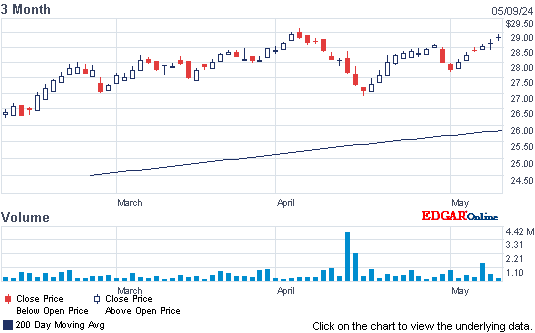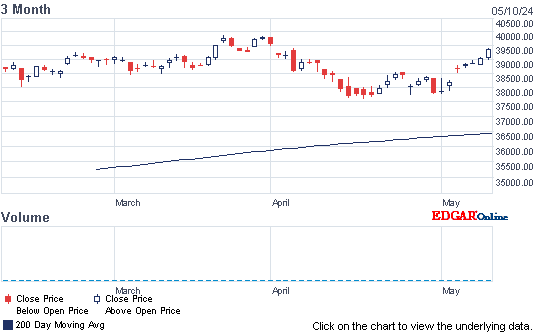Dow dropped 84, decliners over advancers almost 4-1 & NAZ gave back 42. The MLP index was off 5+ to the 315s & the REIT index lost 1+ to the 333s. Junk bond funds continued sliding lower & Treasuries inched higher although the 10 year yield is at a high 2.6%. Oil slumped to the 47s on worries about production cuts (more below) & gold crawled higher hanging in above 1200.
AMJ (Alerian MLP Index tracking fund)

Saudi Arabia told OPEC it raised output back above 10M barrels a day in Feb, reversing about 1/3 of the cuts it made the previous month. The kingdom, which had curbed supplies more than it needed in Jan to lead the way in an accord to re-balance world markets, boosted production by 263K barrels a day to 10.011M a day, according to a monthly report from OPEC. That figure, submitted by Riyadh, jarred with OPEC's estimates, which showed Saudi production falling further last month to 9.8M barrels a day. Even after the increase, Saudi Arabia’s data shows it's cutting output more than required under the terms of OPEC's Nov 30 agreement. Still, it follows a warning from Energy Minister Khalid Al-Falih last week that the kingdom won’t indefinitely “bear the burden of free riders.” Russia, Iraq & the United Arab Emirates are yet to deliver all the curbs they promised. 24 oil producers, led by members of OPEC & Russia, agreed to reduce output in an effort to clear a surplus that has weighed on prices & battered their economies. Crude slipped back below $50 a barrel last week for the first time since Dec as surging stockpiles & production in the US suggest the cuts aren't working fast enough. Speaking at an oil industry conference in Houston last week, Saudi Arabia’s Al-Falih said the country hasn't decided yet whether OPEC should prolong the curbs once they expire in Jun. At 10.011M barrels a day, Saudi output is still below the ceiling of 10.058M a day imposed by the agreement. Production data that OPEC derives from external sources, such as news agencies, showed Saudi output falling 68K barrels a day to 9.797M a day.
Saudis Tell OPEC They Eased Cuts to Pump 10 Million Barrels
German investor confidence rose less than anticipated in Mar as political uncertainty weighed on the outlook of Europe's largest economy. The ZEW Center for European Economic Research said that its index of investor & analyst expectations, which aims to predict economic developments 6 months ahead, climbed to 12.8 from 10.4 in Feb. But economists predicted an increase to 13.0. The data come one day before the Netherlands kicks off a series of elections in the 19-nation euro region that risks to see increased support for populist, euro-skeptical parties. While the Bundesbank predicted last month that German growth would pick up at the start of 2017, a slump in factory orders in Jan highlighted the risks to the outlook. The fact that confidence “only shows a slight upward movement is a reflection of the current uncertainty surrounding future economic development,” ZEW Pres Achim Wambach said. “With regard to the economic situation in Germany, no clear conclusion can be drawn from the most recent economic signals.” ZEW’s gauge for current conditions rose to 77.3 from 76.4 & a measure for expectations in the euro area advanced to 25.6 from 17.1. Earlier today, the Federal Statistics Office confirmed that German inflation accelerated to 2.2% last month, the highest level since 2012.
The Dow is down 300 in Mar. Lower oil prices are a drag along with the political mess in DC. Raising the debt ceiling for Treasury is very big & legislation is stuck in the, somewhat hung up by an inability to move forward on repealing ObamaCare. That must be done before a new tax package aimed at lower taxes is passed. All this uncertainty is hitting home for traders. And they are selling, although not aggressively. The Dow continues to be near record highs & up about 2½K since the election, but DC reality is a major drag. Tomorrow Janet will talk about the rate hike & what to expect in the coming months.
Dow Jones Industrials

AMJ (Alerian MLP Index tracking fund)
US producer prices rose more than forecast in Feb, while costs increased from a year earlier by the most since Mar 2012, signaling inflation is picking up, a Labor Dept report showed. Producer-price index climbed 0.3% from Jan (forecast was for 0.1% gain) after 0.6% jump that was the biggest since Sep 2012. Over 80% of the advance was due to 0.4% increase in services prices. PPI increased 2.2% from Feb 2016 (estimate was 1.9%) following a 1.6% rise in the previous 12-month period. Excluding food & energy, wholesale prices rose 0.3% from the previous month (forecast was 0.2%) & rose 1.5% from Feb 2016. Increased global demand is helping drive up costs of some commodities & allowing price pressures to gradually build in the production pipeline. Higher wholesale costs can lead broader inflation toward the Fed's goal depending on how successful producers are in eventually pushing their costs thru to American consumers. Fed policy makers, meeting today, are projected to raise interest rates as inflation moves higher & the job market continues to improve.
U.S. Producer Prices Climbed More Than Forecast in FebruarySaudi Arabia told OPEC it raised output back above 10M barrels a day in Feb, reversing about 1/3 of the cuts it made the previous month. The kingdom, which had curbed supplies more than it needed in Jan to lead the way in an accord to re-balance world markets, boosted production by 263K barrels a day to 10.011M a day, according to a monthly report from OPEC. That figure, submitted by Riyadh, jarred with OPEC's estimates, which showed Saudi production falling further last month to 9.8M barrels a day. Even after the increase, Saudi Arabia’s data shows it's cutting output more than required under the terms of OPEC's Nov 30 agreement. Still, it follows a warning from Energy Minister Khalid Al-Falih last week that the kingdom won’t indefinitely “bear the burden of free riders.” Russia, Iraq & the United Arab Emirates are yet to deliver all the curbs they promised. 24 oil producers, led by members of OPEC & Russia, agreed to reduce output in an effort to clear a surplus that has weighed on prices & battered their economies. Crude slipped back below $50 a barrel last week for the first time since Dec as surging stockpiles & production in the US suggest the cuts aren't working fast enough. Speaking at an oil industry conference in Houston last week, Saudi Arabia’s Al-Falih said the country hasn't decided yet whether OPEC should prolong the curbs once they expire in Jun. At 10.011M barrels a day, Saudi output is still below the ceiling of 10.058M a day imposed by the agreement. Production data that OPEC derives from external sources, such as news agencies, showed Saudi output falling 68K barrels a day to 9.797M a day.
Saudis Tell OPEC They Eased Cuts to Pump 10 Million Barrels
German investor confidence rose less than anticipated in Mar as political uncertainty weighed on the outlook of Europe's largest economy. The ZEW Center for European Economic Research said that its index of investor & analyst expectations, which aims to predict economic developments 6 months ahead, climbed to 12.8 from 10.4 in Feb. But economists predicted an increase to 13.0. The data come one day before the Netherlands kicks off a series of elections in the 19-nation euro region that risks to see increased support for populist, euro-skeptical parties. While the Bundesbank predicted last month that German growth would pick up at the start of 2017, a slump in factory orders in Jan highlighted the risks to the outlook. The fact that confidence “only shows a slight upward movement is a reflection of the current uncertainty surrounding future economic development,” ZEW Pres Achim Wambach said. “With regard to the economic situation in Germany, no clear conclusion can be drawn from the most recent economic signals.” ZEW’s gauge for current conditions rose to 77.3 from 76.4 & a measure for expectations in the euro area advanced to 25.6 from 17.1. Earlier today, the Federal Statistics Office confirmed that German inflation accelerated to 2.2% last month, the highest level since 2012.
German ZEW Confidence Rises Less Than Forecast on Uncertainty
The Dow is down 300 in Mar. Lower oil prices are a drag along with the political mess in DC. Raising the debt ceiling for Treasury is very big & legislation is stuck in the, somewhat hung up by an inability to move forward on repealing ObamaCare. That must be done before a new tax package aimed at lower taxes is passed. All this uncertainty is hitting home for traders. And they are selling, although not aggressively. The Dow continues to be near record highs & up about 2½K since the election, but DC reality is a major drag. Tomorrow Janet will talk about the rate hike & what to expect in the coming months.
Dow Jones Industrials













No comments:
Post a Comment